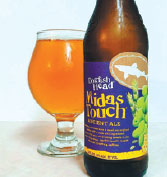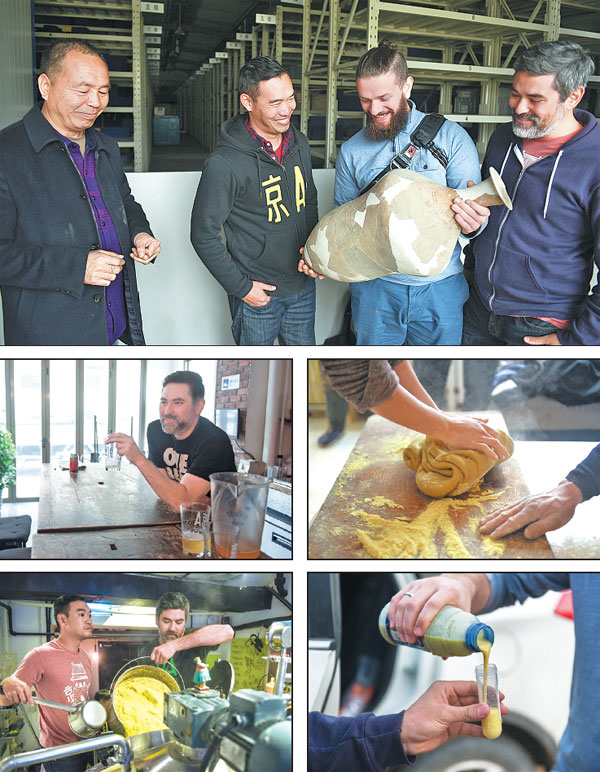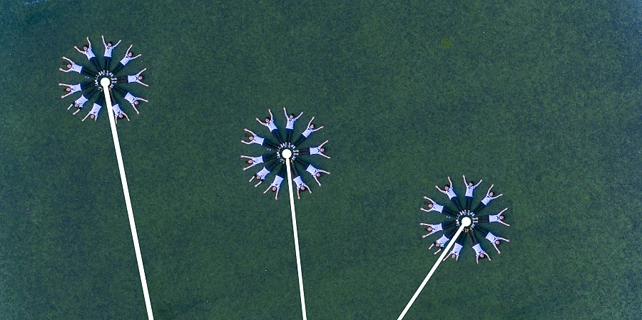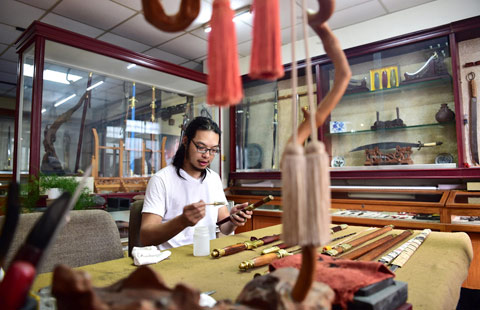Ancient suds in modern mugs
The recent discovery of a 5,000-year-old 'beer-making tool kit' in Shaanxi province inspires craft brewers in China to replicate the historic recipe, Mike Peters reports from Xi'an and Beijing.
It looks like a conventional kitchen. There are big square pans of mountain yams, ready for a 70-minute roasting. Thirty kilos of broomcorn millet are in line for half an hour of steaming. A food processor growls like a chainsaw as it chops up Job's tears, the pearly dried kernels also known as coixseed.
Anybody's grandma would wonder what on Earth we're cooking. The plan here at Beijing's popular craft brewery Jing-A is to re-create what a recently published archaeology study suggests is a 5,000-year-old beer recipe used in China's Central Plain.
"It's definitely one of the most exciting beers we've ever made," says brewery cofounder Alex Acker. He and his business partner, Kristian Li, are toting roaster pans of beer-to-be after making a quick trip to Shaanxi to collect some key ingredients, meet some of the Chinese researchers, and see "the ancient stuff" that inspired the project.
Calling Indiana Jones
In 2004, in two pits at the Mijaya site on a tributary of the Weihe River, archaeologists found the wide-mouthed pots, funnels, and narrow-mouthed jars with pointed bottoms. Many had yellow residues on the inside surfaces, and there was also a primitive stove.
The clay vessels' shape and age dated them to the late Yangshao Neolithic period, between 3500 and 2900 BC. But when Stanford University professor Li Liu and doctoral student Jiajing Wang looked at a 2012 journal report on the findings, they saw a pattern in the artifacts: a pottery stove that could have been heated to break down carbohydrates to sugar, pots suitable for mashing and brewing, funnels for filtration, and storage vessels for the finished products.
Was this one of the world's first microbreweries?
The Stanford group teamed up with Shaanxi archaeologists for a new study. When their analysis of the starches, phytoliths and other residues in the vessels turned up both millet and barley, they were convinced their suspicion was right.
In her class titled Archaeology of Food: Production, Consumption and Ritual, Liu had students replicate the brew as a final project in a campus lab. Now professional craft brewers from Beijing's Jing-A and Hong Kong's Moonzen are eager to try making "ancient beer".
After arriving in Xi'an, our group's first stop is a warehouse labeled: "Storage of Archaeological Objects No 03". Xing Fulai, the leader of the Mijaya dig, unlocks the big steel doors and pulls them apart with a loud clang. Each of us, our inner Indiana Jones primed for excitement, leans in to look.
A few minutes later, the awed modern brewers are allowed to hold some of the clay vessels used by their ancient predecessors.
"These things are more than 10 times as old as America," says photographer Aaron Berkovich.
China has a long history of alcohol production. Evidence of rice-based fermented beverage has been found at the 9,000-year-old Jiahu site in today's Hunan province, but barley-based brewing - our modern notion of beer - had not been recorded until much later.
"In China, the earliest written record of beer appears in oracle bone inscriptions from the late Shang Dynasty (c. 16th century-11th century BC)," the Stanford-Shaanxi researchers wrote in the US National Academy of Sciences journal PNAS in June 2016. "According to the inscriptions, the Shang people used malted grains, including millets and barley/wheat (barley and wheat are represented by the same Chinese character) as the main brewing ingredients." While scholars had speculated that the beer-brewing tradition dated back to the Neolithic Yangshao period, there had been no direct evidence for alcohol production from Yangshao-era sites.
The new research provided evidence of both early alcohol production and a surprise: barley.
"Barley was one of the main ingredients for beer-brewing in other parts of the world, such as ancient Egypt," Wang told National Public Radio in the US. "It is possible that when barley was introduced from Western Eurasia into the Central Plain of China, it came with the knowledge that the crop was a good ingredient for beer brewing."
Enter the yeast wranglers
"The idea," says Jing-A's Acker, "is to pick up where they left off with their research and analysis, and to bring this ancient ale to life. To make our brewing re-creation as authentic as possible, we want to use locally sourced Shaanxi ingredients found in the recipe - broomcorn millet, Job's tears, tubers, etcetera - as well as local fermentation practices."
After visiting the archaeology warehouse, our group proceeds to a wet market nearby for some shopping and friendly debates. About authenticity. About snake gourds and honey. About what beer really is.
While the presence of barley makes the ancient brew fit our modern notion of beer, the "recipe" remains open to interpretation.
"One of the interesting questions here is proportions: How much snake gourd and how much Job's tears?" says Laszlo Raphael, who with his wife, Michele Wong Raphael, operates the microbrewery Moonzen in Hong Kong. The remnants in the vessels may not represent the actual proportions used, and flavoring ingredients more perishable than grains leave no traces after 5,000 years. Honey, for example, has been used in Chinese liquor fermenting for about nine millennia, and sweet and sour additions such as lily bulb, citrus peel, star anise, hawthorn, mulberry and plum were all in wide use when the Mijaya site was in beer-making mode.
The absence of hops in the recipe sparks another discussion. Did various tubers or other ingredients give the ancient brew the sort of bitterness hops does today?
"Sourness was a more likely element than bitterness," suggests Laszlo Raphael of the ancient beer's flavor, echoing the Stanford study leader Wang, who guessed "it would taste a bit sour and a bit sweet."
The Jing-A and Moonzen brewers, who plan to release their versions of the beer on Friday, were eager to find and use "wild" yeast from the Xi'an area. That would give the modern brews an extra patina of authenticity.
"When it comes down to it, we're all really just yeast wranglers - they do all the work," says Raphael. "Without yeast, it's just sugar-water."
Such naturally occurring yeasts can be found on the skins of fruits and berries (such as grapes, apples and peaches), in plant saps and even in the air.
The brewers try a little foraging at first, but eventually get a "very aggressive" yeast starter from a local farmer who makes mijiu, a traditional grain alcohol, by first making a breadlike dough from local fermented grains. Part of the brewers' art will be to monitor the yeast's attenuation, or how much sugar it consumes.
After a few weeks in brewing tanks, the result will be offered to local beer lovers in Beijing and Hong Kong on Friday.
"It's kind of a fun thing for us," says Jing-A's Acker. "We're not brewing a lot of it, so making money is not really our goal here. In fact, we will donate the profits to the research programs at Stanford and Shaanxi to promote more study.
"But the idea of a 5,000-year-old beer recipe from China seemed so cool, we wanted to explore that ancient beer history and give beer fans (including ourselves!) a chance to taste China's first barley-based beer."
Contact the writer at michaelpeters@chinadaily.com.cn
On tap
On Friday, Beijing's Jing-A and Hong Kong's Moonzen breweries will offer craft beers based on a 5,000-year-old recipe. Theirs is not the first modern effort to re-create "ancient beer".
In 1999, Dogfish Head Brewery in the US state of Delaware launched its Ancient Ales series with Midas Touch, a beer-wine-mead brew made with ingredients found in 2,700-year-old drinking vessels from the tomb of King Midas. Since then the series, developed with biomolecular archaeologist and ancient-beer guru Patrick McGovern, has included Chateau Jiahu, based on ingredients unearthed from a 9,000-year-old tomb in China; Theobroma, a celebration of chocolate with cocoa, honey, chilies and annatto based on chemical analysis of 3,400-year-old pottery fragments found in Honduras; and Ta Henket, which uses "ingredients plucked from Egyptian hieroglyphics" and a native Egyptian yeast strain from the night air of Cairo.
|
Midas Touch was the first in a series of "ancient ales" from Dogfish Head. |
A more recent product comes from Seattle's Lucky Envelope Brewing, where Chinese American brewmaster Barry Chan took the information from the Stanford scholars' paper on the Mijaya artifacts and created his rendition for a modern palate.
|
Clockwise from top: Archaeologist Xing Fulai (left) with craft brewers Kristian Li, Laszlo Raphael and Alex Acker; a farmer’s “dough” is the source of wild yeast; collecting wild yeast after dough fermentation; Li (left) and Acker add broomcorn millet to a brewing kettle at JingA; Acker samples the finished beer, slightly sour and ciderlike, this week. Aaron Berkovich / For China Daily |
(China Daily USA 04/18/2017 page8)


















